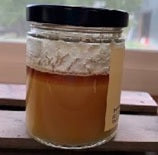Honey Crystallization

Pamela and husband Steve, own and operate
Barton Creek Honey in Barton Creek & Bastrop, TX.
Pamela is a Univ. of Georgia trained honey judge
and has managed the Texas Beekeepers Assn. Honey
Show. She is a Master Beekeeper as well as Cattle rancher -
With honey bee yards located across Texas.
Dear Readers!
Some of you may believe 3300-year-old honey discovered in Egyptian pyramids is "perfectly edible." Aside from taste, the texture of honey found in King Tut's tomb would be far from appetizing!
Depending on the flower source, granulation can be smooth, grainy or crunchy. This granulation is crystallization and is natural and spontaneous. Most liquids crystallize when frozen. Like water, honey, a super-saturated solution of sugars, has a natural chemical action causing it to crystallize.
Unaware honey buyers may assume that crystallized honey is bad, contaminated or an unnatural product. Instead, the opposite is true. Pure raw or unheated honey has a natural tendency to crystallize over time. This action indicates that the honey hasn't been diluted or adulterated and a sign of high-quality honey.
What is crystallization?
All honey begins with nectar, a thin solution of about 80% water that is colorless and not very sweet. Honey bees then add enzymes to the nectar converting the complex sugar into glucose and fructose sugars. Crystallization is based on the ratio of sugars glucose vs. fructose.
Simpler for me is to think of a seesaw - that is the ratio of glucose to fructose. Crystallization will occur in honey with moderate to a high percentage of glucose.
How and why does it happen?
Considerations:
- Flower nectar type - the amount of glucose to fructose ratio
- Cooler temperature - above freezing increases the crystal formation
- Pollen - crystals will attach to pollen or wax bits and replicate
It is hard to locate a report or listing of local plants that measure the percentage of glucose. Instead, word of mouth between beekeepers on the local flora of what will crystallize rapidly or slowly can be reliable. In Texas, it comes to mind that huajilla, mesquite, clover, cotton, fruit trees, Gaillardia (Indian Blanket) and sunflowers have rapid crystallization.
In Canada and the Dakota states, canola or rapeseed crystallizes rapidly,and are therefore used for industrial or baking uses. Yaupon, Chinese tallow, star thistle and horse-mint are known as "slow to crystallize."
Cool temperature also cause crystals to form. If you want to make creamed honey, the target temperature is between 55 - 57 degrees Fahrenheit. Some industrial honey packers heat honey to high temperatures (pasteurizing) as well as utilizing high pressure heated filtration (eliminate pollen) to ensure honey remains liquefied for many years.
Pollen, bits of wax, even a dust particle will cause honey to form crystals. The glucose molecules will then cling to the particles and sink to the bottom.
Many of us strain our honey with metal strainers or with plastic strainers of 400/600 micron size, allowing pollen to pass through. Therefore, this honey crystallizes more rapidly! This is considered a "sure sign" of pure natural honey!
What to do?
If your honey crystallizes after you bottle it there are solutions - pun intended! Freezing Honey will not crystallize at or below 32 F.
Freezing
Honey before it crystallizes is the best and most straightforward way to avoid crystallization without killing the natural

Honey Crystallizes from the bottom up

We freeze bottles of honey to preserve them and add buckets once we empty the honey supers and make space.
Warming Honey
Heat dissolves crystals in fresh honey. Honey that has already crystallized will soften at 85 degrees F. and begin to liquefy between 100 and 104 degrees F. If honey crystallizes after bottling, place it in a pan of warm water or on your truck or car dashboard in our sunny Texas heat. Note: Microwaving can cause overheating, destroying the natural enzymes in honey.

Hobart warming cabinet

Non working freezer warming cabinet
As a bucket of honey thickens in storage, we use warming cabinets. One is an old freezer with light bulbs inside and the other a used Hobart restaurant warming cabinet with temperature control. If you are using an old freezer, an InkBird Digital Temperature Controller works well to keep it at 90 - 110 F.

There are heater jackets available that wrap around a bucket to warm Honey.

Bee equipment suppliers offer bottling tanks(jacketed double boilers) that come with no-drip valves making filling bottles a cleaner task.
Creamed Honey
Dr. Dyce patented the creamed honey process many years ago while researching fermentation spoilage at Cornell University in the 1930's.
A honey product made by heating honey to a temperature sufficient to destroy yeasts; quickly cooling it to a temperature below the melting point of honey crystals, preferably about 75 degrees F., adding about 5% of fine grained crystalline honey, agitating the honey to distribute said nuclei uniformly throughout the honey, and controlling the temperature within a few degrees of 57 degrees F., whereby a fine-grained, fondant-like product is formed
Crystallized honey is not spoiled!
My favorite is creamed honey - a recipe for the beekeeper to use to produce a delightful spreadable honey that is delicious to the palate.

Creamed honey made four years ago and left in a warm honey house - separated

Honey higher in glucose will crystallize hard, and those lower in glucose crystallize much softer. This can cause issues when trying to produce creamed honey for sale.
Age does affect the consistency of crystallized honey. Just like in King Tut's tomb, the amount of glucose decreases and it slowly coverts to other sugars. The appearance is of "separation" - liquid on top, solid on bottom...in time, becoming almost entirely liquid again.
-Pamela Yeamans - Baron Creek Honey

